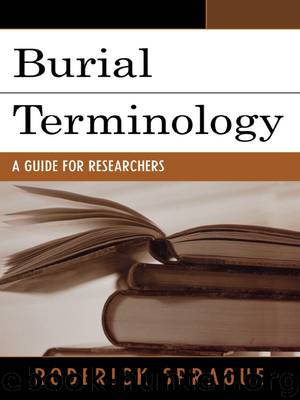Burial Terminology: A Guide for Researchers by Sprague Roderick

Author:Sprague, Roderick
Language: eng
Format: epub
ISBN: 9780759114708
Publisher: AltaMira Press
Published: 2013-07-10T16:00:00+00:00
In a platform cremation, “the human remains were burnt on an open platform, and the ashes then covered” (Hogg 1940:326). A tract extolling the virtues of cremation (United States Cremation Company 1897:21) defines cremation as reduction in “open retorts or on the pyre” and “incineration” as reduction “in a closed retort.”
“Crematoriums,” “cremation pits,” “exposure towers,” and so on are structures or features of the reduction process but often become the disposal area. Dincauze (1968:64-65) refers to the inhumation of cremation remains cremated elsewhere as a “secondary burial pit,” a usage anticipated by Yarrow (1880:18) but not endorsed here. Kurtz and Boardman (1971:26, 73,195) specifically define a “primary cremation” as the body burned in the grave (“cremated on the spot” [Mrozoski 1955:74], the body was burned in the grave cutting [Morris 1992:179]), and a “secondary cremation” as the body burned elsewhere and then placed in the grave or urn (“burned elsewhere and redeposited” [Ubelaker 1999:35]). McGuire (1992:57) makes these same distinctions with a primary cremation defined clearly as “pits in which a body was both burned and interred.” A secondary cremation is defined (McGuire 1992:78) as the “burning of the body at one location and then burying the remains and grave goods in a separate pit.” The secondary cremations are divided into “pit,” “urn,” and “trench” (McGuire 1992:58). This usage of primary and secondary would often but not necessarily coincide with the definitions used in this work.
Brannon (1938:231) makes still another distinction between remains placed in an urn after cremation and bones placed in an urn with hot or live coals and then interred. This distinction is between the secondary placement of cremated remains in an urn and the secondary cremation, in an urn, of remains skeletonized prior to burning. Skeletonized, a useful term, is defined by Quigley (2001:251) as “the reduction of a human body to its skeletal elements, usually by natural processes.” The final phrase appears unnecessary.
Reinhard and Fink (1982:152-155) present a detailed and excellent set of definitions for cremation terminology. Their “primary cremation” (“the process of burning a body on a pyre [or combustion pile] or over a shallow pit and leaving the ashes and bone where they fall without separating the bone for burial else-where”) is in general agreement with the earlier definitions. “Secondary cremation” (“the sorting of bone from the ash at the place of burning and interring the separated bone at some point away from the place of burning”) is also generally in agreement with prior usage. No need is seen, however, for the distinction of separating the bone from the ash. This “gleaning” is defined as “sorting bone from the crematory after firing for burial elsewhere.” In most areas, apparently in contrast to the American Southwest, this is more likely the result of how the bone or bone and ash are picked up rather than any cultural intent. Reinhard and Fink (1982) are quite correct in pointing out that a secondary cremation is incomplete and “not totally representative of an actual cremation.” They suggest
Download
This site does not store any files on its server. We only index and link to content provided by other sites. Please contact the content providers to delete copyright contents if any and email us, we'll remove relevant links or contents immediately.
Nudge - Improving Decisions about Health, Wealth, and Happiness by Thaler Sunstein(7213)
iGen by Jean M. Twenge(5137)
The Fire Next Time by James Baldwin(4998)
Adulting by Kelly Williams Brown(4209)
The Hacking of the American Mind by Robert H. Lustig(4064)
The Sports Rules Book by Human Kinetics(4057)
The Ethical Slut by Janet W. Hardy(4019)
Captivate by Vanessa Van Edwards(3705)
Mummy Knew by Lisa James(3507)
In a Sunburned Country by Bill Bryson(3344)
The Worm at the Core by Sheldon Solomon(3306)
Ants Among Elephants by Sujatha Gidla(3270)
Suicide: A Study in Sociology by Emile Durkheim(2891)
The Slow Fix: Solve Problems, Work Smarter, and Live Better In a World Addicted to Speed by Carl Honore(2827)
The 48 laws of power by Robert Greene & Joost Elffers(2765)
Humans of New York by Brandon Stanton(2669)
Handbook of Forensic Sociology and Psychology by Stephen J. Morewitz & Mark L. Goldstein(2594)
The Happy Hooker by Xaviera Hollander(2568)
The Tipping Point by Malcolm Gladwell(2535)
